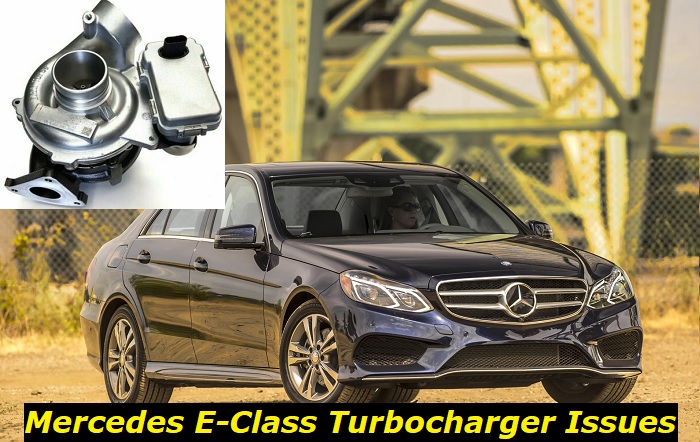The Mercedes-Benz E-Class is such an amazing car coming from the three-pointed star marque. It sits just below the S-Class, so it benefits from some of the bells and whistles found in the flagship car of its brand. Driving a luxury vehicle can be such a breeze with the performance, comfort, safety, and technologies it offers. However, there are certain signs that you should watch out for as you enjoy your ride, which may point to the turbocharger problems it is known for over the years.
Key features and my opinion about the M264 engine
- Production years:2018-now
- Average lifespan of M264:160,000-190,000 miles
- Fuel supply type:direct injection
- Power range:190-306 hp
- Fuel efficiency:good
- Engine block material:aluminum
- Engine reliability score:high
- The most common problems:Camtronic problems, carbon buildup on intake valves, additional emission filter potential issues at high mileage.

In this article, we will show you the most common problems related to the turbocharger of the E-Class for your reference. Based on recall announcements, reports, and customer reviews, these include the following:
1. Loose Turbocharger Oil Feed and Return Lines
To start things off, let's begin with the most recent recall of Mercedes-Benz USA (MBUSA) concerning the E350 trim of the 2020 E-Class range in particular. According to the notice the company sent to customers in June 2020, there's a possibility that the people or machines at its assembly plant failed to tighten the screws holding the turbocharger oil feed and return lines in place. The issue could potentially lead to an oil leak in the said areas.
The advisory went on to warn affected customers that if the problem is left unchecked, the leaking oil may seep through the ignition sources of the engine. The hot temperature produced by the engine and its exhaust components present potential overheating issues that may render the power unit of the car inoperable or may even result in a fire that may lead to the vehicle's total write-off.
As a consequence, MBUSA offered to fix the problem free of charge during the recall duration. Therefore, if your E-Class is covered by the recall or is still under warranty by Mercedes, you should bring your auto to them for repairs if you happen to be suffering from the same issues. However, if you already missed out on the boat or your warranty has already been voided for any reason, feel free to have your auto serviced by any reputable auto shop to save on the repair costs.
Aside from leaks, symptoms such as reduced engine performance, poor smoke quality coming from the exhaust, and rattling noise coming from the turbocharger could mean that there is a problem with your turbocharger oil feed or return lines.
The turbocharger oil feed and return lines are responsible for supplying oil to the turbocharger and for returning used oil to the engine. The feed line supplies fresh, clean oil to the turbocharger while the return line takes away used oil that has been contaminated with debris and dirt. These lines are essential in keeping your turbocharger running smoothly and efficiently, hence, you have to maintain their good condition.
In most instances, the screws of the turbocharger oil feed or return lines may only need tightening to their recommended torque. On the other hand, the screws may need to be replaced if they're defective. Furthermore, if the problem has caused damage to the feed and lines, the worn parts will have to be changed with new ones.
2. Turbo Actuator Fault
A recurring problem with various trims of the E-Class, namely the E220, E270, and E320, from 2002 onwards is a turbo actuator fault. A turbo actuator is a vital component in a vehicle equipped with a turbocharger. It is responsible for controlling the movement of the wastegate valve, which regulates the amount of exhaust gas that bypasses the turbine. If the actuator fails, it can cause a number of problems for the vehicle.
One symptom of a faulty turbo actuator is poor engine performance. The engine may feel sluggish and have reduced power. This can be exacerbated by other issues such as a clogged air filter or low engine oil level. Another symptom is unusual engine noise. The wastegate valve may not close properly, resulting in increased exhaust noise.
There are several possible causes of turbo actuator failure. One is simply wear and tear over time. The actuator is a mechanical component and, like any other, it can break down with age and use. Another possible cause is contamination. If the actuator gets dirty or full of debris, it can malfunction.
There are a few likely solutions to turbo actuator failure. One is to simply replace the actuator. This is often the most effective solution, although it can be expensive. Another solution is to clean the actuator if it is contaminated. This may be enough to restore its function. Finally, some mechanics may be able to repair the actuator instead of replacing it. This option can save money but may not be as effective as a replacement.
If you are experiencing symptoms of a turbo actuator failure, it is important to have the problem diagnosed and repaired as soon as possible. Turbochargers are vital components of many modern vehicles and, when they fail, can cause significant problems. With prompt diagnosis and repair, you can avoid major issues and keep your vehicle running smoothly.
3. Clogged Compressor Air Intake Duct
If your Mercedes E-Class has a clogged compressor air intake duct in its turbocharger, some symptoms will indicate it. The car may run less smoothly, or the engine may make strange noises. You may also notice that the car's performance is reduced.
The cause of a clogged compressor air intake duct is typically dirt or debris buildup within the duct. This can happen over time as the ducts age and accumulate debris. Solutions to this problem include cleaning out the ducts and replacing them if necessary.
The most common solution to this problem is cleaning out the ducts. This can be done with a brush or compressed air. However, if the clogging has resulted in damage to certain components, the worst that could happen is having to rebuild your turbocharger.
If you suspect that your turbo has a clogged compressor air intake duct, it's important to have it checked out by a qualified mechanic. Only a trained professional will be able to diagnose the problem and recommend the best course of action.
4. Seized Turbine Wheel
If you notice that your car's turbocharger is making strange noises or not working as efficiently as it used to, there's a possibility that the turbine wheel has seized. This can cause many problems for your car, and it's important to be aware of the symptoms so you can get the issue fixed as soon as possible.
One of the most common symptoms of a seized turbine wheel is an unusual noise coming from the turbocharger. This could be a grinding noise, or simply a louder than normal noise when the turbo is in use. Another symptom is reduced power output from the engine. This can be noticed when accelerating or going up hills, as the car simply won't have the same get-up-and-go as it used to. Finally, if the turbine wheel has seized completely, you may notice smoke coming from the turbocharger itself.
There are a few different possible causes of a seized turbine wheel. One is simply age and wear and tear - over time, parts can start to break down and seize up. Another possibility is oil starvation - if the turbo isn't getting enough oil, it can cause the bearings to overheat and seize. Finally, debris or contamination in the oil can also cause seizing.
If you think your turbine wheel has seized, the best course of action is to take it to a qualified mechanic or dealership for repair. They will be able to diagnose the problem and replace any necessary parts. In some cases, simply flushing the oil and replacing it with fresh oil can solve the issue. However, if the problem is more severe, such as damaged bearings or shaft, then the turbocharger will need to be replaced entirely.
Don't ignore signs that your turbine wheel has seized. If it's left unchecked, it can cause serious damage to your engine. Be sure to get it fixed as soon as possible so you can keep driving without worry.
5. Cracked Turbine Housing
A cracked turbine housing is one of the worst things that could happen to your turbocharger. This can cause several problems for your car, and it is important to be aware of the symptoms so that you can get the problem fixed as soon as possible.
The first symptom of a broken turbine housing is usually a decrease in performance. Your car may not accelerate as quickly as it used to, or it may start to hesitate when you try to speed up. You may also notice that your fuel economy has decreased because the fractured housing is causing your engine to work harder than it should.
Another symptom of this problem is unusual noises coming from the turbocharger itself. You may hear a hissing or whistling sound when the turbo is running, or you may hear a knocking noise coming from under the hood. These noises are caused by exhaust gases leaking through the faults in the housing.
There are a few things that can cause a crack in the turbine housing. The most common cause is simply age because, over time, the metal of the housing can weaken and eventually crack. Another possibility is that the housing was damaged during installation. If it was not installed correctly, it may be more susceptible to wear.
There are ways to fix cracked turbine housing. The most common is to simply replace the housing with a new one. This is usually the best option, as it ensures that the housing will be installed correctly and will not have any pre-existing damage. If the damage is not too severe, it may be possible to weld the cracks shut. However, this is not always effective and it can weaken the overall structure of the housing. The worst-case scenario would require your entire turbo assembly to be rebuilt or replaced.
A cracked turbine housing is a serious problem that can cause major damage to your engine if it is not fixed. If you notice any of the symptoms, take your car to a mechanic as soon as possible so that they can diagnose the problem and make the necessary repairs.
Conclusion
To optimize the driving pleasure that you can get out of your Mercedes E-Class, it should always be free from any problems, especially mechanical issues. So, if you suddenly find yourself encountering any of the symptoms discussed here that point to its various turbocharger problems, don't hesitate to bring your car to an experienced mechanic or a Mercedes dealership right away.
About the authors
The CarAraC research team is composed of seasoned auto mechanics and automotive industry professionals, including individuals with advanced degrees and certifications in their field. Our team members boast prestigious credentials, reflecting their extensive knowledge and skills. These qualifications include: IMI: Institute of the Motor Industry, ASE-Certified Master Automobile Technicians; Coventry University, Graduate of MA in Automotive Journalism; Politecnico di Torino, Italy, MS Automotive Engineering; Ss. Cyril and Methodius University in Skopje, Mechanical University in Skopje; TOC Automotive College; DHA Suffa University, Department of Mechanical Engineering






Add comment